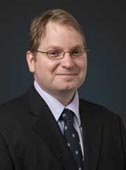Focusing on New
Treatments with
Ultrasound

Todd Mainprize
|
Todd Mainprize is focusing
on clinical research
in neuro-oncology. He
works with Kullervo
Hynynen, a physicist who
has developed a technique
of putting ultrasound
through the bone - brain
barrier, using the skull as
a lens to focus the modality
on intracranial lesions.
There are two trials
currently recruiting
patients. One is for ablation, using ultrasound to abolish
tumors or treat motor disorders causing tremor. This
will be the second centre in the world to undertake these
studies. The second trial will work on opening the blood-brain barrier accurately in short and limited areas for
drug delivery: drugs for psychiatric or for chemo-therapeutic
treatment. Both of these studies are now funded
and waiting entry of their first patients. The blood- brain
barrier puncture seals in 12 hours. There are extensive
animal trials to prove the principle, most of them carried
out at Sunnybrook and at Brigham and Women’s
Hospital, where Kullervo practiced before he came to
Toronto. Because of publicity of the potential benefits of
this modality, there are many calls from patients requesting
entry into treatment. The Foundation that funds
these studies- The Focused Ultrasound Foundation - was
started by novelist John Grisham.
The treatment is delivered from a helmet with 1024
arrays to focus the treatment. There are two such helmets
purchased through grants: one for high and one
for low intensity ultrasound. If the treatment proves
effective, it will have applications, for example, metastases
in bone and liver. There are currently high intensity
ultrasound ablation programs, such as those described in
Dr. Choti’s Palmer Lecture in the summer issue (http://www.surgicalspotlight.ca/Article.aspx?ver=Spring-Summer_2012&f=PalmerHepatic). The blood brain
barrier penetration protocol can be used for primary
tumors in the brain, such as glioblastoma, as well as
for brain metastases. It will allow penetration of drugs,
such as Taxol, which is effective against glioblastoma in
vitro, but is unable to penetrate the blood-brain barrier
in the absence of a disrupting force, such as ultrasound.
Glioblastomas migrate along the white matter of the
brain, 93% of them recur within 2 centimeters of the
primary lesion, despite apparently complete excision.
The blood-brain barrier penetration protocol may allow
access of drugs for non-oncologic condition, such as
Parkinson’s disease, Alzheimer’s disease and psychiatric
conditions. Todd is working on the proof of principle
phase, penetrating the blood –brain barrier prior to
surgical therapy, adding the drug and then sampling the
tumor and surrounding tissue at the time of surgery.
|
“Talking to patients about these preliminary trials has
been easy, as patients understand the uncertainty and
novelty of the treatment when it is explained to them
honestly.” The instruments used in this research cost
several millions of dollars. The accounting for the cost
of neurosurgical treatment was described in an earlier
article about Michael Tymianski and his colleagues at
Toronto Western. The technique is being applied in a
preliminary form at Sunnybrook.
“The limitation of this treatment is the intense heat
generated by the energy form. The skull absorbs much
energy despite a 17 degree water cap. Energy sufficient to
cause ablation can only be focused centrally, not near to
the scalp or skull. It is thus not useful for meningiomas
or for metastases which generally occur along the graywhite
barrier. Those somewhat rare tumors of appropriate
size that occur in basal ganglia are appropriate for
the protocol.
“In general, ultrasound is benign when it is used
diffusely, but coordinated at 1 point, it can raise the
tissue temperature to 55 degrees, causing coagulation.
Penetration of the blood brain barrier requires far less
energy. For example, around 1% of the energy used in
the ablation studies produces bubbles in the capillaries.
They expand under ultrasound activation, disrupt the
intracellular junctions, and allow drugs to cross the barrier.
Oscillation of the bubbles does not take a great deal
of energy and the bubble does the surgery”.
Todd and Kullervo are currently working with lipo-somes, which can be ruptured by ultrasound to facilitate
the spread of drugs such as Doxyrubicin in a focal area.
One of the problems with the protocol is that the lesions
must be of a prescribed size -2.5 centimeters or less. This
is not usually possible with recurrent glioblastomas.
Todd joined the Neurosurgery residency in 1996,
spent several years in Jim Rutka’s laboratory and joined
the faculty at Sunnybrook in the Neurosurgery division
in 2008. There are six surgeons in the Division. He is
married to Susan, a pharmacist and informatics specialist.
They live in Leaside with their children, Graham 7,
Thomas 4 and Victoria 2.
M.M.
|